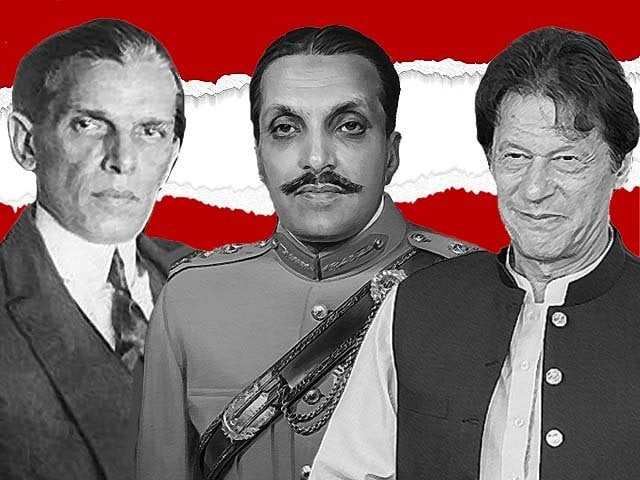One could argue that Pakistan is not suffering from symptoms of hyper nationalism and pan-Islamism, at least, not to the extent of its neighbour India where the ideology of Hinduvta is coursing through a large section of the Indian society. However, Pakistan’s make-up, at its very core, is overwhelmingly religious. Even though it is a South Asian state which was carved out of India, it appears Pakistan is obsessed with finding a way to link itself with the Middle East in order to align itself with Islamic history, which ironically will only further its historical amnesia.
Pakistan’s constitutional history has experienced a number of aberrations and therefore, has been drafted and implemented thrice. The conflict that arises due to the attempted amalgamation of religion and politics is due to the Objectives Resolution 1949. The resolution is considered a primordial piece of law that is deemed to be of utmost importance to the constitution itself. The Objectives Resolution passed in 1949 was taken as the preamble of the previous constitutions passed. In 1985, due to Zia’s rampant Islamisation, it was introduced as Article 2 and Article 2A through the eighth amendment which made it an integral part of the constitution.
However, Pakistan’s movement towards becoming an overzealous religious society can be traced back to pre-partition times. It is a known fact that Pakistan and India’s constitutional differences were pronounced from the very beginning. The contrasting political and ideological approaches adopted by the dominant parties of the two countries before partition led to successive civilian governments in one country and a stop-start democratic process in the other.
In her book The Promise of Power: The Origins of Democracy in India and Autocracy in Pakistan Maya Tudor points out some very basic reasons for the difference between political setups that governed the two states post partition.
Firstly, there was a difference in the types of social classes that were leading the political parties and by extension, the two countries at the time. In Pakistan’s case, it was the Muslim land-owner aristocracy and peasants who led the freedom struggle. In Congress’s case, it was the educated urban middle class who motivated the less affluent members of society against the British Raj. The second factor that influenced the nature of Pakistan as a state was the strength of the dominant political parties and consequentially, the interests they represented. It was foreseeable that the All India Muslim League was the only party that was going to rule Pakistan following partition. In India’s case, Congress was the one with the majority, but it wasn’t the only political party in existence and therefore, different and diverging class interests were represented.
Tudor then draws a comparison with the type of alliances formed within and outside the party which also set a pattern for the type of “regime” post partition. In this regard, the third aspect that influenced constitutional formulation in Pakistan was the alliances formed by the Muslim League. As discussed in the previous points, the Muslim League primarily consisted of Nawabs or rather, aristocrats. There was a clear divide between the poorer segments of society and their leaders. An attempt to bridge this gap was made through religion and so, the clergy was given greater importance and a more visible role in politics. Ultimately, it led to the formal creation of an Islamic republic and arguably, a discriminatory constitution.
Pakistan has had three constitutions; one issued in 1956, another in 1962 and finally, the present day 1973 constitution. The 1956 version has had a noticeable impact on the existing constitution whereas some portions from the 1962 draft have also been included.The 1973 constitution is considered to be democratic by large sections of society, however, it is the very nature of the document which ironically contests the claims of Pakistan being a democratic state.
A cursory look will show us that the preamble of the constitution known as the “Objectives Resolution of 1949” essentially ends the case for Pakistan ever becoming a secular society. The term secular in Urdu means ladeeniyah, that is; not to do with religion whereas, the word stands for the separation of religion and politics. The adoption of the Objectives Resolution was enacted in order to give the process of drafting the constitution a direction.
The resolution starts by stating that sovereignty belongs to Allah. It then goes on to elaborate that the authority is given by Him to the state of Pakistan through its people is to be exercised within the limits set by Him. Throughout the rest of its text, it continues to mark the case for Islam to be the state religion, for instance, by stating that,
“the principles of democracy, freedom, equality, tolerance and social justice as enunciated by Islam shall be fully observed.”
The resolution, when put forward by Liaquat Ali Khan, was vehemently opposed by the non-Muslim members of the parliament. The members included Prem Hari Barma and Srisi Chandra Chattopadhyaya. These members asked for a motion that elicited public opinion instead of one that was directed to empower one particular religion. However, this proposal was vetoed by Liaquat Ali Khan. This exemplified how the lawmakers of that time were laying the foundation of a religiously zealous society. The speech by Birat Chandra Mandal debated that in India, pundits did not force the political thinkers to use terms that promoted a particular religion and even the pre-dominantly Christian America abstains from doing the same, why was the Pakistani constitution being subjected to such a limitation?
The concerns put forward by most of the minority members were regarding religious terminology. They wanted to omit words such as “enunciated by Islam,” and replace them with generalised, democratic and inclusive terms. Countless other suggestions were given and debated upon, but the Objectives Resolution 1949 of the nascent state passed without giving due credence to the wishes of its minority.
Admittedly, Zia made the situation tangibly worse when he came into power. He started by making the resolution a part of the constitution itself. Therefore, instead of being the preamble, it became a codified portion of the document in the form of article 2A. Furthermore, the original resolution stated that,
“adequate provision shall be made for the minorities to freely profess and practice their religions and develop their cultures.”
Zia removed the term “freely” from the above provision, essentially signifying his intent to turn Pakistan into a constrictive environment for non-Muslims. Prior to this, one can say that the resolution was an overarching stipulation to create an Islamic society, but Zia brought the inherent deficiencies of its text to the forefront. The tone of religious acrimony had already been set back in 1949 and Zia merely expedited it.
Therefore, although Zia receives the lion share of the blame for the complete Islamisation of the nation, it can be seen that, from the very beginning, our political leardership, barring Jinnah, intended for the constitution to make democratic secular principles subservient to that of Islamic ideology and the whims of the local clergy.



COMMENTS
Comments are moderated and generally will be posted if they are on-topic and not abusive.
For more information, please see our Comments FAQ